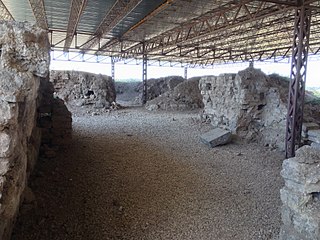
Alalakh is an ancient archaeological site approximately 20 kilometres (12 mi) northeast of Antakya in what is now Turkey's Hatay Province. It flourished, as an urban settlement, in the Middle and Late Bronze Age, c. 2000-1200 BC. The city contained palaces, temples, private houses and fortifications. The remains of Alalakh have formed an extensive mound covering around 22 hectares. In Late Bronze Age, Alalakh was the capital of the local kingdom of Mukiš.
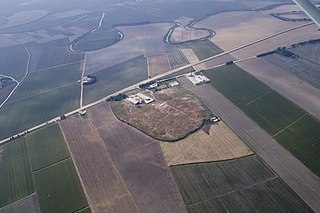
Tell Ta'yinat is a low-lying ancient tell on the east bank at the bend of the Orontes River where it flows through the Amuq valley, in the Hatay province of southeastern Turkey about 25 kilometers south east of Antakya, and lies near Tell Atchana, the site of the ancient city of Alalakh. Tell Ta'yinat has been proposed as the site of Alalaḫu, inhabited in late 3rd millennium BC, mentioned in Ebla's Palace G archive; and in later times as Kinalua, the capital city of an Iron Age Neo-Hittite kingdom.

Tell Tweini, possibly the ancient town of Gibala, is a 12 hectare archaeological site located 1 kilometre east of the modern city of Jableh, Syria. It is situated within the coastal plain of Jableh, a short distance of two other main archaeological sites: Tell Sukas (5 km) and Tell Siyannu (6 km). As a tell, the site is the result of centuries of habitation on the same place, which resulted in a rising mound, as every new generation built their houses on top of the remains of older structures. The tell is sited about 1.7 kilometers from the coast but it appears that in the Bronze Age a sea incursion provided a harbor access to the sea.
Hamoukar is a large archaeological site located in the Jazira region of northeastern Syria, near the Iraqi and Turkish borders. The early settlement dates back to the 5th millennium BCE, and it existed simultaneously with the Ubaid and the early Uruk cultures. It was a big centre of obsidian production. In the 3rd millennium, this was one of the largest cities of Northern Mesopotamia, and extended to 105 ha.

Tell Fekheriye is an ancient site in the Khabur River basin in the Al Hasakah Governorate of northern Syria. It is securely identified as the site of Sikkan, attested since c. 2000 BC. While under an Assyrian governor c. 1000 BC it was called Sikani. Sikkan was part of the Aramaean kingdom of Bit Bahiani in the early 1st millennium BC. In the area, several mounds, called tells, can be found in close proximity: Tell Fekheriye, Ra's al-'Ayn, and 2.5 kilometers east of Tell Halaf, site of the Aramean and Neo-Assyrian city of Guzana. During the excavation, the Tell Fekheriye bilingual inscription was discovered at the site, which provides the source of information about Hadad-yith'i.

Alishar Hüyük was an ancient Near Eastern city. It is near the modern village of Alişar, Sorgun.

The Amik Valley is a plain in Hatay Province, southern Turkey. It is close to the city of Antakya. Along with Dabiq in northwestern Syria, it is believed to be one of two possible sites of the battle of Armageddon according to Islamic eschatology.

Alacahöyük or Alaca Höyük is the site of a Neolithic and Hittite settlement and is an important archaeological site. It is situated near the village of Alacahüyük in the Alaca District of Çorum Province, Turkey, northeast of Boğazkale, where the ancient capital city Hattusa of the Hittite Empire was situated. Its Hittite name is unknown: connections with Arinna, Tawiniya, and Zippalanda have all been suggested.

In the archaeology of Southwest Asia, the Late Neolithic, also known as the Ceramic Neolithic or Pottery Neolithic, is the final part of the Neolithic period, following on from the Pre-Pottery Neolithic and preceding the Chalcolithic. It is sometimes further divided into Pottery Neolithic A (PNA) and Pottery Neolithic B (PNB) phases.

Pottery and ceramics have been produced in the Levant since prehistoric times.
Tell Arbid is an ancient Near East archaeological site in the Khabur River Basin region of Al-Hasakah Governorate, Syria, about 50 kilometers north northeast of modern Al-Hasakah. It is located 45 kilometers south of Tell Mozan, the site of ancient Urkesh and about 15 kilometers from the site of Chagar Bazar. The Halafian site of Tell Arbid Abyad is a short distance away.
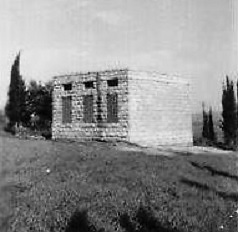
Abu Zurayq is an archaeological site located on the western edge of the Jezreel Valley and its transition to the Menashe Heights, next to Highway 66, between the modern kibbutzim of HaZore'a and Mishmar HaEmek.
Chogha Bonut is an archaeological site in south-western Iran, located in the Khuzistan Province.

Tell Sabi Abyad is an archaeological site in the Balikh River valley in northern Syria. It lies about 2 kilometers south of Tell Hammam et-Turkman.The site consists of four prehistoric mounds that are numbered Tell Sabi Abyad I to IV. Extensive excavations showed that these sites were inhabited already around 7500 to 5500 BC, although not always at the same time; the settlement shifted back and forth among these four sites.

Dark faced burnished ware or DFBW is the second oldest form of pottery developed in the western world, the oldest being Dotted wavy line pottery from Africa.
Leila Badre is a Lebanese archaeologist and director of the Archaeological Museum of the American University of Beirut.
Tell Kazel is an oval-shaped tell that measures 350 m × 325 m at its base, narrowing to 200 m × 200 m at its top. It is located in the Safita district of the Tartus Governorate in Syria in the north of the Akkar plain on the north of the al-Abrash river approximately 18 km (11 mi) south of Tartus.
The Halaf-Ubaid Transitional period or HUT is a prehistoric period of Mesopotamia. It lies chronologically between the Halaf period and the Ubaid period. It is still a complex and rather poorly understood period. At the same time, recent efforts were made to study the gradual change from Halaf style pottery to Ubaid style pottery in various parts of North Mesopotamia.
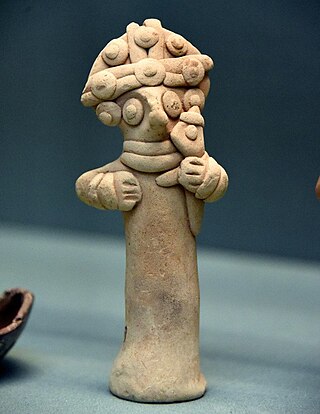
The Euphrates Syrian Pillar Figurines (EU_SPF's) are anthropomorphic clay figurines dating from the late Iron Age period and produced in the Middle Euphrates region. These figurines are part of a greater coroplastic production mainly composed of handmade horse-rider figurines, i.e. the Euphrates Handmade Syrian Horses and Riders (EU_HSHR's).
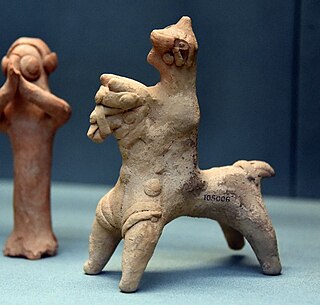
The Euphrates Handmade Syrian Horses and Riders are zoomorphic clay figurines representing horses and horses with riders. They date from the late Iron Age period and were produced in the Middle Euphrates region, alongside anthropomorphic figures known as Euphrates Syrian Pillar Figurines (EU_SPFs).
















